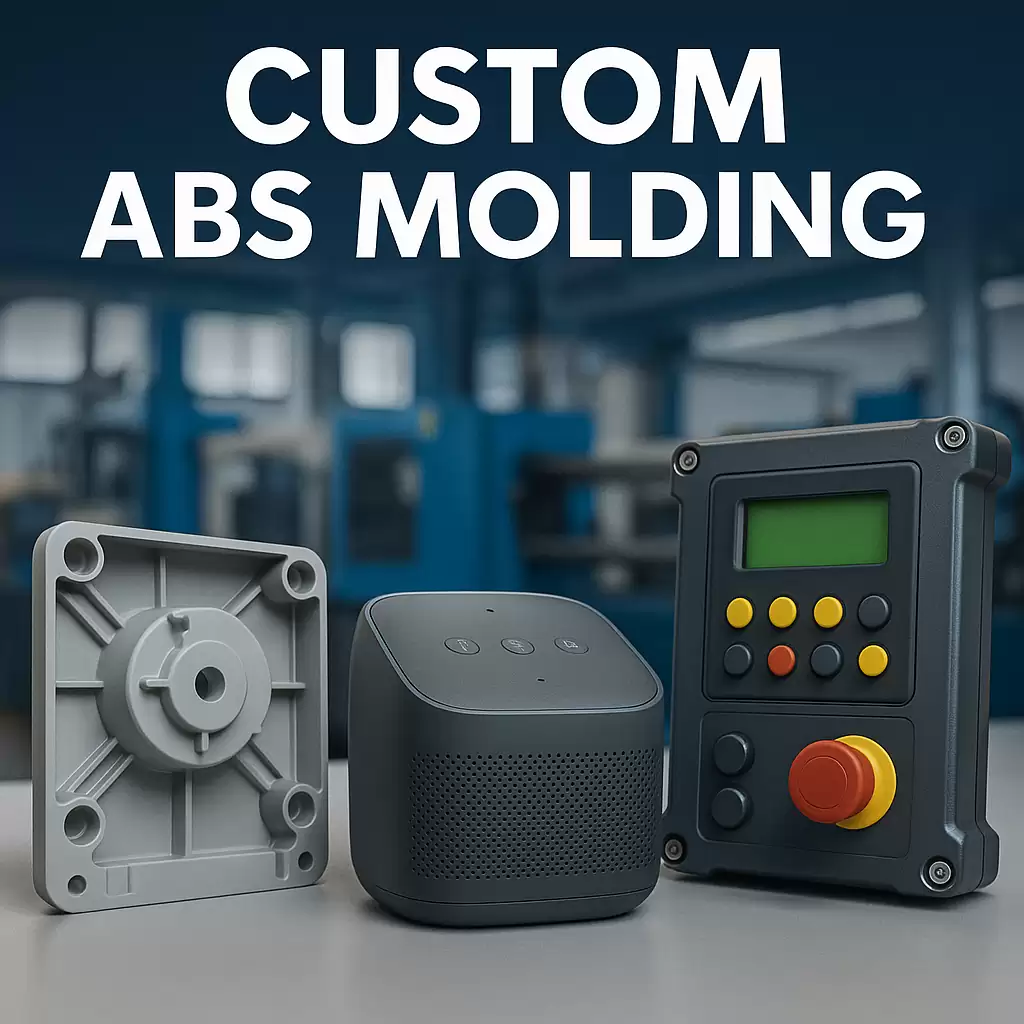Utilize Custom ABS Plastic Molding for Consumer Devices & Industrial Applications
Utilize Custom ABS Plastic Molding for Consumer Devices & Industrial Applications
Acrylonitrile-Butadiene-Styrene (ABS) remains the “goldilocks” resin for parts that demand impact strength, crisp aesthetics, and robust processability—at a price point that keeps margins healthy. Whether you’re building a next-generation smart speaker or a rugged industrial control panel, custom ABS injection molding delivers the versatility, finish, and mechanical performance you need. Below is a practical guide to turning ABS into high-value products that delight users and survive real-world abuse.
1 Why ABS Continues to Dominate Across Sectors
| Property | What It Means in Practice |
|---|---|
| Balanced Impact & Rigidity | Drop-resistance for handheld devices, yet stiff enough for tight screw bosses. |
| Low‐Temperature Toughness | Maintains impact strength to –20 °C—ideal for factory floors and outdoor kiosks. |
| Superior Moldability | Flows easily into thin ribs, engravings, and snap-fits without burning or flash. |
| Excellent Paintability & Plating | Accepts UV-cure paint, IMD, soft-touch over-mold, or metallic vacuum plating. |
| Color Accuracy | Natural whiteness enables vivid Pantone matching and light-diffusing grades. |
| Cost-Effective | 20–30 % cheaper than PC or PC/ABS blends while meeting most enclosure specs. |
2 Material Choices: Standard, High-Heat & Specialty ABS
| Grade | Key Additives / Traits | Typical Use Case |
|---|---|---|
| General-Purpose ABS | None—balanced modulus & impact | Set-top boxes, toys, indoor IoT hubs |
| High-Gloss ABS | Flow modifiers & anti-scratch | Premium appliance fronts, laptop bezels |
| Flame-Retardant (FR) ABS | Halogen-free or brominated UL-94 V-0 | Charging stations, power strips |
| High-Heat ABS (HH) / ABS-PC | Siloxane + polycarbonate alloy | Automotive interiors, hot-running gearboxes |
| Biobased or Re-cycled ABS | >40 % bio content or PCR resin | Eco-labelled consumer products |
Tip: Request datasheets listing Izod impact, HDT, and UL-94 rating to confirm a grade meets both mechanical and compliance targets.
3 Design Guidelines for A-Class Finishes & Structural Integrity
-
Wall Thickness Maintain 1.5–3 mm (±15 %) to prevent sink and voids.
-
Ribs & Bosses Height ≤ 3× wall; thickness 0.6–0.8× wall for warp-free reinforcement.
-
Living Hinges Use thin (0.3–0.4 mm) sections of modified ABS or switch to PP over-mold.
-
Snap-Fits Incorporate 0.5 mm under-cut with fillets; draft 0.5–1° for smooth assembly.
-
Texture vs. Gloss SPI-A2 polish for lenses; MT-11000 or VDI-18 texture hides flow lines.
-
EMI Shielding Apply vacuum metallization or conductive paint; design 360° wraparound geometry.
4 Process Parameters That Make or Break Quality
| Parameter | Recommended Window | Impact on Part |
|---|---|---|
| Melt Temp | 220 – 260 °C (grade specific) | Too low → knit lines; too high → yellowing |
| Mold Temp | 50 – 80 °C | Higher temps improve gloss & dimensional stability |
| Injection Speed | Medium–High | Fills thin ribs without jetting |
| Pack/Hold Pressure | 90 % of peak injection | Eliminates sink on bosses |
| Cooling Time | Optimize via Moldflow | Up to 60 % of cycle—conformal cooling reduces cost |
Scientific Molding Approach: Use cavity-pressure sensors to set V/P switchover exactly when the gate freezes; lock the process window with CpK > 1.67 before mass production.
5 Stand-Out Applications & Value-Add Options
| Sector | ABS Part | Value-Add Process |
|---|---|---|
| Consumer Electronics | Smart-speaker grills, VR headset shells | Laser-etch lighting icons behind paint |
| Automotive | Dashboard trim, HVAC louvers | Graining texture + soft-touch TPE over-mold |
| Industrial IoT | DIN-rail enclosures, HMI bezels | EMI shielding + gasket grooves in one shot |
| Medical Devices | Portable diagnostic housings | Anti-microbial ABS grades + ultrasonic welding |
| Retail Fixtures | POS terminal covers | In-mold decoration (IMD) with brand graphics |
6 Case Snapshot: ABS for Rugged Handheld Scanner
| Metric | PC Original | Custom FR-ABS Solution |
|---|---|---|
| Resin Cost (kg) | US $4.10 | US $2.85 |
| Drop Test @ 1.5 m | Pass | Pass |
| Injection Cycle | 28 s | 22 s (lower melt & cooling) |
| Cosmetic Rejects | 3.2 % | 0.8 % |
| Annual Savings (250 k pcs) | — | US $165 k |
7 Why Source ABS Molding Via TaiwanMoldMaker.com?
-
Grade Availability: 500+ ABS variants—standard through FR V-0—stocked locally for 1-week sampling.
-
Optical + Texturing Expertise: SPI-A1 mirror to VDI-30 EDM textures executed in-house.
-
Bridge-to-Scale Programs: Aluminum prototype tools upgraded to multi-cavity P20 or H13 with cost credit.
-
Integrated Secondary Ops: Pad-printing, soft-touch over-mold, laser engraving, and EMI coating under one roof.
-
Data-Driven QC: Cavity-pressure sensors, eDart charts, and full ISO 9001 / IATF 16949 traceability.
8 Action Plan—Launch Your ABS Project Fast
-
Define CTQs (Critical-to-Quality): impact/drop spec, gloss, flammability, and color.
-
Send CAD + CTQ List to TaiwanMoldMaker.com for a 48-hour DFM & quote.
-
Approve Tool Design with Moldflow cooling & warp study.
-
Prototype in Aluminum Tool (1–3 weeks) using final ABS grade.
-
Validate & Iterate —functional, cosmetic, and regulatory tests.
-
Scale to Multi-Cavity Steel with locked scientific molding window.
Ready to Harness Custom ABS Molding?
Share your design files and performance targets with TaiwanMoldMaker.com to be matched with vetted molders who transform ABS into durable, high-impact parts for consumer and industrial products alike—on time and on budget.









